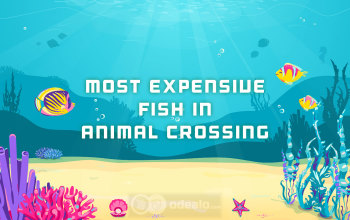Animal Crossing: New Horizons
The Most Expensive Fish Guide
Introduction
Fishing, in Animal Crossing: New Horizons, is not only relaxing and entertaining but can also be surprisingly profitable. The amount of money you earn from fishing depends on the kinds of fish you catch, as they vary greatly in value; the cheapest of them are worth mere 100 Bells, while the rarest and most difficult to hook can be worth 150 times as much. You might think that this is all RNG and you have to get lucky to catch a really rare and expensive fish, but this is not the case (not entirely, at least). The chance of catching a particular fish is not completely random as there are some factors and rules that apply; different fish have different active hours, are available in different parts of the year, inhabit different waters, and their presence is indicated by different fish shadows. You can use these pieces of information to your advantage and tip the RNG in your favor. To help you with that, we have prepared a list of The Most Expensive Fish in Animal Crossing: New Horizons that features all the information you'll ever need.
|
 
Buying ACNH Bells with real money is a hassle-free way to get all the items you need for your character.
|
The Most Expensive Fish in New Horizons
Location descriptions might be a bit confusing at first glance, so here are some explanations:
- Clifftop - This means that the given fish only inhabits pools of water on the elevated levels of your island (getting there might require a ladder).
- Pier - Some fish can only be caught at the Pier; a pre-existing wooden structure that just into the ocean. Your island will always have a Pier, either on the eastern or the western coast.
- River Mouth - The place where a river falls into the sea.
- During Rain - The fish will only take the bait when it is raining (some of them are just fickle like that).
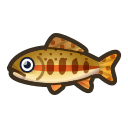
Golden Trout |
15000
Price (Bells)
|
River and Pond (Clifftop)
Location
|
|
Seasonality
- Northern Hemisphere - March-May, September-November,
- Southern Hemisphere - March-May, September-November,
|
| Active Hours - 4 PM - 9 AM |
| Golden Trout (Lat. Oncorhynchus aguabonita), one of the most expensive fish in Animal Crossing: New Horizons, inhabits only high mountain streams known for their clear waters (Golden Trouts are extremely susceptible to pollution and will not inhabit rivers that exhibit even a trace of it). In the game, this very rare fish can be found in the clifftop ponds and rivers (rivers and ponds on the elevated parts of islands), but only during the nighttime. The medium-sized fish shadow indicates that there is a chance of catching it. If you manage to catch a Golden Trout, consider yourself very lucky as it sells for a whopping amount of 15k Bells. |

Stringfish |
15000
Price (Bells)
|
River (Clifftop)
Location
|
|
Seasonality
- Northern Hemisphere - December-March,
- Southern Hemisphere - June-September,
|
| Active Hours - 4 PM - 9 AM |
| This extremely rare fish (after you donate a Stringfist to the museum, the curator states that it must have been the most difficult fish to catch yet) can only be caught in winter (December-March in Northern Hemisphere, and June-September in Southern Hemisphere), and only during the nighttime. Just like Golden Trout, Stringfish (Lat. Parahucho perryi), also known as Japanese huchen, inhabits elevated parts of rivers (ones found on clifftops). Stringfish occupies the shared first place on the list of the most expensive fish in New Horizons and sells for 15000 Bells. |
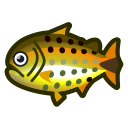
Dorado |
15000
Price (Bells)
|
River
Location
|
|
Seasonality
- Northern Hemisphere - June-September,
- Southern Hemisphere - December-March,
|
| Active Hours - 4 PM - 9 AM |
| Dorado (Lat. Salminus maxillosus) can be considered the summer equivalent of the Stringfish. Just like the Stringfish, it is extremely rare and very valuable, but unlike it, Dorado appears only during summer (June-December in the Northern Hem, and December-March in the Southern Hem) and only during the daytime. In real life, Salminus maxillosus can be found in rivers of South America; the Parana River is its main habitat. The presence of the very large fish shadow in the water might indicate that there is a Dorado waiting to be caught. Catching one of these will put 15000B in your pocket. |
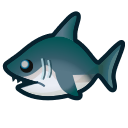
Great White Shark |
15000
Price (Bells)
|
Sea
Location
|
|
Seasonality
- Northern Hemisphere - June-September,
- Southern Hemisphere - December-March,
|
| Active Hours - 4 PM - 9 AM |
| The Great White Sharks (Lat. Carcharodon carcharias) are some of the biggest and most dangerous sea creatures that can be caught in Animal Crossing: New Horizons. These predators achieve sizes of about 5 meters and have a very bad reputation, thanks to movies like Jaws (1975). Great White Sharks can only be found in Seas during the warmer months, and only during the daytime. The potential presence of one of these dangerous creatures is indicated by a Huge Fish shadow with a fin. After you donate one to the museum, the curator tells you about their teeth and their ability to regrow them in a single day. The Great White Shark sells for a nice sum of 15k Bells. |
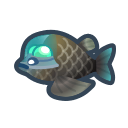
Barreleye |
15000
Price (Bells)
|
Sea
Location
|
|
Seasonality
- Northern Hemisphere - Whole Year
- Southern Hemisphere - Whole Year
|
| Active Hours - 9 PM - 4 AM |
| Barreleye (Lat. Macropinna microstoma) can be easily recognized thanks to a highly unusual fluid-filled dome on its head through which some of its internal organs can be clearly seen. This curious feature has some very useful applications; for example, the Barreleye can see through the insides of its head, which makes spotting potential prey or predators lurking above it much easier! This uniquely-looking and very rare fish inhabits extreme depths of the Pacific, Atlantic, and Indian Oceans. Despite being known for over 80 years, it was first photographed in 2004. Barreleye can be caught in Seas and is available for the whole year in both Hemispheres, but only at night. Catching one of these will get you 15k Bells (or more if you sell it to C.J.). |
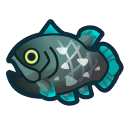
Coelacanth |
15000
Price (Bells)
|
Sea (During Rain)
Location
|
|
Seasonality
- Northern Hemisphere - Whole Year
- Southern Hemisphere - Whole Year
|
| Active Hours - All Day |
| The West Indian Ocean coelacanth (Lat. Latimeria chalumnae) was thought to be extinct a very long time ago until a colony of it was discovered in 1938. This is one of the oldest and most primitive fish species still in existence, often called a "living fossil"; coelacanths are around for over 400 million years which makes them much older than many dinosaurs. They inhabit deep parts of the seas, can weigh up to 80kg and achieve the length of about 2 meters. In New Horizons, this extremely elusive fish can be caught for a whole year but only when it's raining; its potential presence is indicated by a large fish shadow. |
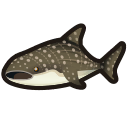
Whale Shark |
13000
Price (Bells)
|
Sea
Location
|
|
Seasonality
- Northern Hemisphere - June-September,
- Southern Hemisphere - December-March,
|
| Active Hours - All Day |
| The mighty Whale Shark (Lat. Rhincodon typus) is the largest species of fish currently living on earth (the largest confirmed specimen had a length of ~18.8 meters). Despite being called a "shark", this fish is actually very gentle (Whale Sharks do not pose any threat to humans) and, despite having a very large mouth, is not a predator. In Fact, Whale Shark is a filter feeder, which means that it feeds on plankton and small fishes that it filters directly from the water. In Animal Crossing: New Horizons, the potential presence of a Whale Shark in the Sea is indicated by a Huge Shadow with a fin. This giant fish can only be caught during the warmer parts of the year and seeks food for the whole day. Catching one of these majestic creatures will effectively put 13000 Bells into your pocket. |

Saw Shark |
12000
Price (Bells)
|
Sea
Location
|
|
Seasonality
- Northern Hemisphere - June-September,
- Southern Hemisphere - December-March,
|
| Active Hours - 4 PM - 9 AM |
| Saw Shark (Lat. Pristiophorus japonicus) owes his name to a unique saw-like bill edged with sharp teeth that it uses to disable its prey and even to dig it out of the sand if needed. This interesting and dangerous creature is most commonly found in the waters of the Southern Pacific and Indian Oceans. Saw Shark that appears in New Horizons is actually the Japanese Sawshark. It reaches up to 1.35 meters and is found over the muddy or sandy bottoms of the continental shelf at depths up to 800 meters. If you want to catch one of these uniquely-looking fish, you have to fish in Seas during the summer nights; the Saw Shark only appears during the nighttime, in the summer. |
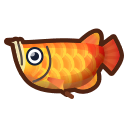
Arowana |
10000
Price (Bells)
|
River
Location
|
|
Seasonality
- Northern Hemisphere - June-September,
- Southern Hemisphere - December-March,
|
| Active Hours - 4 PM - 9 AM |
| The Asian Arowana (Lat. Scleropages formosus) inhabits blackwater rivers (a type of river that moves slowly through forested wetlands or swamps) of Southeast Asia. Juvenile arowanas feed on insects, while adults are fully-fledged predators that prey on other fish. Arowana has a special cultural significance in Chinese culture, where it is believed to be a symbol of prosperity and good luck, thanks to its resemblance to the Chinese dragon. Despite not being as rare as some other fish on the list, Arowana is still one of the most expensive fish in Animal Crossing: New Horizons (it is worth 10000 Bells). It appears during the summer months and can only be caught at night, in rivers. |
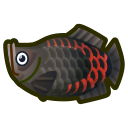
Arapaima |
10000
Price (Bells)
|
River
Location
|
|
Seasonality
- Northern Hemisphere - June-September,
- Southern Hemisphere - December-March,
|
| Active Hours - 4 PM - 9 AM |
| The Arapaima (Lat. Arapaima gigas), also known as the pirarucu, is a species of freshwater fish native to the basin of the Amazon River. Arapaimas commonly grow to over 2m in length and can achieve a weight of over 200 kilograms. They are obligate air-breathers, which means that they have to regularly come to the surface to gulp air. After you donate one of these fish to the museum, you will hear that male Arapaimas hold their young in their mouths to protect them while female ones fend off predators. In New Horizons, Arapaimas can be found in Rivers and their potential presence is indicated by a Huge Shadow. They appear during the late summer and can only be caught at night. |
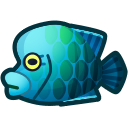
Napoleonfish |
10000
Price (Bells)
|
Sea
Location
|
|
Seasonality
- Northern Hemisphere - July and August,
- Southern Hemisphere - January and February,
|
| Active Hours - 4 AM - 9 PM |
| The Napoleonfish (Lat. Cheilinus undulatus) is a large, brightly-colored oceanic fish found on coral reefs of the Indo-Pacific region. It can be easily recognized by a distinctive humped head and small green indented eyes. Male specimens of Napoleonfish can reach lengths of up to 2 meters and weight of over 180 kilograms (females are a bit smaller), but their length rarely exceeds 100cm. Unlike some other reef fish, Cheilinus undulatus prefers to live on its own, but adult specimens are sometimes observed moving in small schools. In Animal Crossing: New Horizons, Napoleonfish can be caught in Seas, but only in mid-summer, and only during the day. Its potential presence is indicated by a Huge Fish shadow. Catching one of these will put 10k Bells into your pocket. |
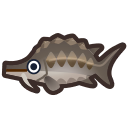
Sturgeon |
10000
Price (Bells)
|
River (River Mouth)
Location
|
|
Seasonality
- Northern Hemisphere - September-March,
- Southern Hemisphere - March-September,
|
| Active Hours - All Day |
| Sturgeon (Lat. Acipenser oxyrinchus) is a species of long-lived, late-maturing fish with a spindle-like, smooth-skinned body armored with five lateral rows of bony plates (but lacking scales). Fish of this kind first appear in the fossil record over 300 million years ago, which makes them one of the most ancient still-living fishes. Since their dawn, Sturgeons have undergone remarkably little morphological change, which makes them a "living fossil". In Animal Crossing, Sturgeons inhabit River Mouths and only appear during the colder parts of the year. The presence of Sturgeons might be indicated by a Very Large fish shadow. They sell for a nice sum of 10000 Bells. |
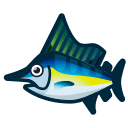
Blue Marlin |
10000
Price (Bells)
|
Pier
Location
|
|
Seasonality
- Northern Hemisphere - November-April, July-September,
- Southern Hemisphere - January-March, May-October,
|
| Active Hours - All Day |
| The Atlantic Blue Marlin (Lat. Makaira nigricans) is a species of large predator fish that inhabits the tropical and subtropical waters of the Atlantic Ocean. Blue Marlin females grow up to four times as large as males and can achieve over 5 meters in length and 800 kilograms in mass. Thanks to its considerable size, only few predators pose danger a Blue Marlin (Sharks, Killer Whales, and of course Humans who catch them for sport). Due to overfishing, Blue Marlin is currently considered a threatened species by the IUCN (International Union for Conservation of Nature). In Animal Crossing: New Horizons, Blue Marlin can be caught in Seas, close to the Pier. It is available for the whole day from November to April and from July to September (in the Northern Hem), and from January to March and from May to October (in the Southern Hem); its potential presence is indicated by a Huge Fish Shadow. Catching one of these beasts will put 10k Bells into your pocket. |
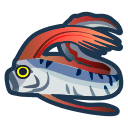
Oarfish |
9000
Price (Bells)
|
Sea
Location
|
|
Seasonality
- Northern Hemisphere - December-May,
- Southern Hemisphere - June-November,
|
| Active Hours - All Day |
| The Oarfish (Lat. Regalecus glesne) is a large and elongated open-ocean fish found in oceans at depths between 200 and 1000 meters, which is very rarely seen on the surface (usually, if one floats to the surface, it doesn't survive for long); Because of the absence of oceanic currents in deep seas, the Oarfish does not build up too much muscle mass, which means that it is not suited for survival in the turbulent shallow water (it is too weak to fight the current). Because of its elongated shape, Oarfish might have been the cause for the myths about ship-crushing sea serpents that were told by mariners in the age of sail. In Animal Crossing, the Oarfish appears in Seas during the colder parts of the year and seeks food all day. Its presence is indicated by a Huge Fish Shadow. Catching one of these will earn you 9000 Bells (13500 if you sell it to C.J.). |
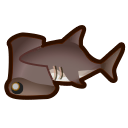
Hammerhead Shark |
8000
Price (Bells)
|
Sea
Location
|
|
Seasonality
- Northern Hemisphere - June-September,
- Southern Hemisphere - December-March,
|
| Active Hours - 4 PM - 9 AM |
| The Hammerhead Shark (Lat. Sphyrna zygaena) is one of the most distinctively-looking shark species. It is easily recognizable thanks to its "hammer-shaped" head with eyes placed on the far ends of the "hammer" (hence the name). This weirdly-shaped head, and the placement of eyes on it, allows the Hammerhead Shark to see 360 degrees around itself, which is greatly beneficial during searching for prey. Hammerhead Sharks of the species featured in Animal Crossing reach up to 5 meters in length and can weigh up to 400 kilograms. They can be caught during the summer months and are active at night. They are not as expensive as the Great White Sharks, but will still sell for a nice sum of 8000 Bells. The presence of a Hammerhead Shark might be indicated by a Huge Fish Shadow with a fin. |
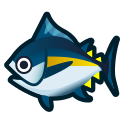
Tuna |
7000
Price (Bells)
|
Pier
Location
|
|
Seasonality
- Northern Hemisphere - November-April,
- Southern Hemisphere - May-October,
|
| Active Hours - All Day |
| The Atlantic bluefin tuna (Lat. Thunnus thynnus) was one of the most common species of tuna in the Scombridae family, but due to severe overfishing, its stocks have declined by over 75% in recent 40 years (because of its taste attributes, Atlantic bluefin tuna has been the foundation of one of the world's most profitable commercial fisheries. This tasty sea fish reaches up to 680 kilograms in mass, 2.5 meters in length, and can easily reach speeds of 64 kilometers per hour. In New Horizons, a Tuna can only be caught at the Pier, and only during the colder part of the year; the fact that it seeks food for the whole day makes hooking it a bit easier. Raccoons at your Nook's Cranny will pay 7000 Bells for one of these, which makes it one of the most lucrative fish available in winter. |
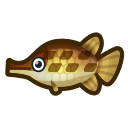
Gar |
6000
Price (Bells)
|
Pond
Location
|
|
Seasonality
- Northern Hemisphere - June-September,
- Southern Hemisphere - December-March,
|
| Active Hours - 4 PM - 9 AM |
| Spotted gar (Lat. Lepisosteus oculatus), a freshwater fish native to North America, is one of the most voracious predators one can catch in Animal Crossing. This sharp-toothed fish is the main predator in the food chains of many rivers and lakes and does not have any predators of its own (only adolescent specimens, at an early life stage, sometimes get eaten by other carnivorous fish). In Animal Crossing, Gar only appears in the late summer and is only active at night, like a true predator should. Catching it will put 6000 Bells into your pocket, which makes it the most expensive Pond fish in the game (except the Golden Trout, which only appears on Clifftops). The potential presence of a Gar in a pond is indicated by a Huge Fish Shadow. |

Mahi-Mahi |
6000
Price (Bells)
|
Pier
Location
|
|
Seasonality
- Northern Hemisphere - May-October,
- Southern Hemisphere - November-April,
|
| Active Hours - All Day |
| Mahi-mahi (Lat. Coryphaena hippurus) is a tropical and subtropical, surface-dwelling saltwater fish, also known as dorado (not to be confused with the Salminus maxillosus, which appears in Animal Crossing under that name and is a freshwater fish). Mahi-mahi is the most common in the waters of Costa Rica, Hawaii, and the Gulf of Mexico. It reaches up to 1 meter in length and commonly weighs about 13 kilograms (the biggest reported specimen weighed over 18kg). The Mahi-mahi was introduced in New Horizons, is available during summer for the whole day, and is worth 6000 Bells when caught and sold at the Nook's Cranny or 9000 Bells when sold to C.J. |
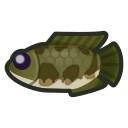
Giant Snakehead |
5500
Price (Bells)
|
Pond
Location
|
|
Seasonality
- Northern Hemisphere - June-August,
- Southern Hemisphere - December-February,
|
| Active Hours - 9 AM - 4 PM |
| Giant snakehead (Lat. Channa micropeltes) is a fish native to freshwaters of Southeast Asia but was also introduced in other parts of the world where it is considered invasive (a species not native to a specific habitat that has the tendency to spread at a degree believed to cause damage to the environment). Giant snakehead can reach up to 1.5 meters in length and weigh over 20 kilograms. It is very resilient and can survive in very muddy and polluted waters. In New Horizons, it is one of the most expensive Animal Crossing: New Horizons Fish you can catch while fishing in a Pond. Giant Snakehead is only available in the summer and seeks food during the day; selling it at the Nook's Cranny will earn you 5500 Bells. |
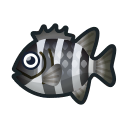
Barred Knifejaw |
5000
Price (Bells)
|
Sea
Location
|
|
Seasonality
- Northern Hemisphere - March-November,
- Southern Hemisphere - September-May,
|
| Active Hours - All Day |
| Barred Knifejaw (Lat. Oplegnathus fasciatus), also known as the Striped Beakfish, is a species of saltwater fish native to the northwestern parts of the Pacific Ocean. It inhabits rocky reefs and can be found at depths from 1 to 10 meters, where it feeds on hard-shelled invertebrates, like molluscs and crustaceans. Barred Knifejaw has high commercial importance and is commonly aquafarmed. In Animal Crossing: New Horizons, it can be caught during all parts of the day, but only in spring and summer. The presence of a Barred Knifejaw might be indicated by the appearance of a Medium Fish Shadow. It can be sold for 5000 Bells at your Nook's Cranny. |
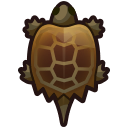
Snapping Turtle |
5000
Price (Bells)
|
River
Location
|
|
Seasonality
- Northern Hemisphere - April-October,
- Southern Hemisphere - October-April,
|
| Active Hours - 9 PM - 4 AM |
| Snapping turtle (Lat. Chelydra serpentina) is a species of large freshwater carnivorous turtle native to North America. The species is known for its aggressive behavior when out of the water (however, it is rather calm, yet curious, in its natural environment) and powerful beak-like jaws, strong enough to crush bone with ease. Picking up these creatures is ill-advised as their flexible necks allow them to turn their heads in a way that allows the turtle to bite a person that is holding them by the sides of their shell (which is infeasible for other turtle species). In New Horizons, Snapping Turtle is active during the night time and can be found in Rivers, but only during the warmer half of the year (April-October in the Northern Hem, and October-April in the Southern Hem). Selling one of these at your Nook's Cranny will earn you 5000 Bells. |
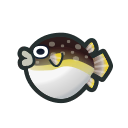
Blowfish |
5000
Price (Bells)
|
Sea
Location
|
|
Seasonality
- Northern Hemisphere - November-February,
- Southern Hemisphere - May-August,
|
| Active Hours - 9 PM - A PM (Northern Hem), 6 PM - 4 AM (Southern Hem) |
| Blowfish (Lat. Takifugu rubripes) is a saltwater fish native to the Yellow Sea, the East China Sea, and the Sea of Japan. Its distinguishing factor is its very short genome that has been fully sequenced (Blowfish is a commonly-used model species in genetic research and is often used as a reference in genomics). Just like other species of pufferfish, Takifugu rubripes is highly toxic because of the tetrodotoxin present in some of its organs. Despite that, Blowfish (and other pufferfishes, collectively known as Fugu, just like the name of the dish that is prepared from them) is used to prepare a special dish; its preparation takes a lot of skill because all toxic parts have to be removed before consumption (the preparation of Fugu is strictly controlled by law in Japan and several other countries). In Animal Crossing: New Horizons, Blowfish can be caught during the night time and only shows up in winter. |
|
 
Odealo supports player-to-player trading for Animal Crossing New Horizons. Buying from regular players on Odealo guarantees the best prices and highest security of every transaction.
|
|
END NOTE
With the help of this guide, you should be able to maximize your chances of catching some of the most expensive fish in Animal Crossing: New Horizons; use it to your advantage.
We hope that you have found this guide useful and informative. If you liked it and want us to add more fish to it, please let us know! Also, we will be happy to receive constructive criticism that will help us improve our future work so leave your suggestions in the comments section below.
|
Pictures used in this article are the intellectual property of Nintendo.

